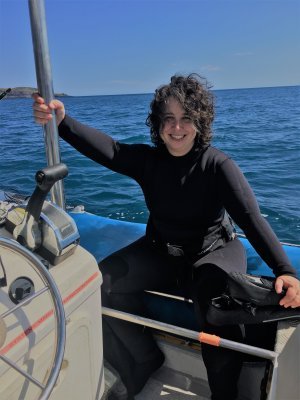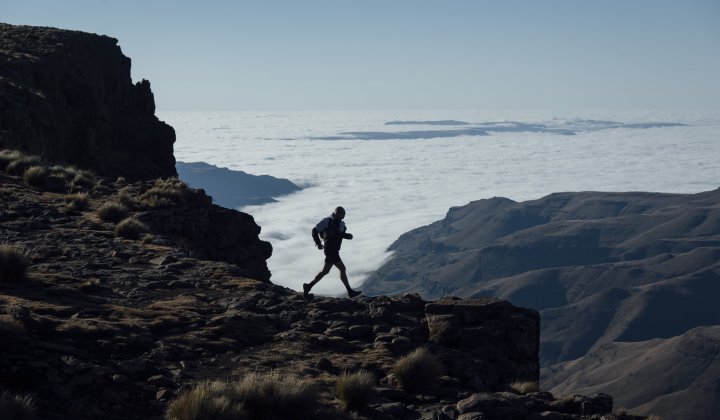The ocean has inspired Sara Andreotti from a young age. It’s why she became a marine biologist and why, as CEO of Stellenbosch-based SharkSafe Barrier, she’s passionate about protecting the sea.
“SharkSafe Barrier keeps sharks and humans separated in areas where the presence of sharks affects tourism,” she says. “We create nature-inspired barriers that look like thick forests of kelp. We also merge these biomimicry aspects with strong magnetism to create a field that overwhelms a shark’s electromagnetic senses and pushes them away. By using the system, rather than shark nets, we hope to create a more eco-friendly and sustainable coexistence between swimmers and sharks, all without damaging marine life.”
Marketing a product that never existed before made her feel like she was “trying to sell a car in a world where everyone is using horses”. But thanks to Ocean Hub Africa, a Cape Town-based impact accelerator, she’s been able to connect with like-minded people who understand the importance of solving this problem. And, as more people get to know the work she does, and start pushing for it to be adopted, governments are paying attention, too.
“A government’s responsibility is to ensure the wellbeing of its people,” she says. “So, the moment the government understands the importance of the blue economy and sustainable utilisation of the ocean, we’ll realise how killing sharks in the name of tourism is nonsensical. Sharks are the top predators of the ocean and are responsible for maintaining the ecosystem balance that ensures our fisheries are sustainable in the long term.”
All things are connected
Indeed, governments worldwide are realising how important the ocean is, and what an incredible source of wealth the ocean can be, as long as it is well-managed and not overexploited. This is the essence of the blue economy.
“It’s about understanding the big picture,” Andreotti says. “By working with the ocean, you can get sustainable resources for feeding people, you can close some areas to make nature reserves for enhancing biodiversity, and you can run educational programmes to teach kids and adults about the marine environment.”
Andreotti believes that the ocean can provide income without affecting the ecosystem, as long as we understand how all things are connected. The problem is that many people seem to be working and thinking in isolation, with “all the puzzle pieces kept separate from each other and only now being put together for the first time”.
“The old system was put in place in Australia in 1930 and South Africa in 1950,” she says. “Reunion Island also had a shark culling programme where they fished Bull Shark and Tiger Shark and threw them away because they have too much heavy metal in their bodies, which makes them inedible. So, the way SharkSafe Barrier fits into this puzzle is by reducing shark mortality. We allow for tourism again in areas where revenue has been declining because of the presence of sharks.”
Adapt in the best possible way
Andreotti wants to promote social engagement. By creating a platform to show everyone how much richness and life there is beneath the surface, more people will start to care.
“I’d like to see governments make informed decisions when it comes to the ocean,” she says. “Up until now, the entire world has been working under the assumption that the ocean is an infinite source of food and space. But that’s simply not the case. Everything we do affects it. Also, we as land animals aren’t supposed to touch the ocean in the first place. But we’ve been touching it for so many years that we now have to put extra effort to fix the problem we created.”
The solution for Andreotti comes down to decisions based on fact. It’s about understanding the impact of what we take out of the ocean (and what we dump in) while also having programmes to keep track of how the environment changes over time.
“It’s not a static situation where you get information today and can base policies on that for the next 20 years,” she says. “It’s a constantly changing environment so data must be collected continuously so that we can adapt in the best possible way.”
Ultimately, there are so many things that can be improved. One of these is to create more marine-protected areas where animals can thrive; not just by not getting fished but also because in these protected areas, the silence helps them communicate.
“That’s why Ocean Hub Africa is a step in the right direction,” Andreotti says. “It’s pushing governments and businesses to look at the situation now, and start working towards a better future.”
Underwater energy generation
Working towards that better future will also require us to rethink how we get our energy. And while many sustainable solutions tend to focus on land, it’s also possible to get sustainable energy from the sea.
“It starts with an understanding of what’s underwater and the fact that water, like air, has a current that moves around all the time,” says Shailin Moodley, a junior engineer at Johannesburg-based Brayfoil Technologies. “So being able to show people underwater currents and how they move is fundamental to getting them to understand that all those teachings [about wind energy] can be translated underwater as well.”
One of the main barriers to underwater energy generation is the capital outlay required for installation and ongoing maintenance. But given the potential return, Moodley believes it’s worth pursuing.
“There’s roughly one thousand times more energy available underwater because it’s one thousand times as dense as the air that we breathe,” he says. “And because of that, the forces that the active Brayfoil wings experience underwater are also one thousand times more powerful.”
A mutually beneficial relationship
But before we rush ahead and do more damage in the name of progress, Moodley urges caution. For him, the main focus of the blue economy should be on going back to a symbiotic working relationship between humans and nature; not extracting value and trashing our beautiful oceans but trying to preserve them as much as possible.
“With respect to energy generation, we need to be looking at methods for working with how nature has evolved to work on its own,” he says. “It’s not about trying to redirect the natural flows of current and moving fish out of their natural habitats, but instead, allowing nature to exist as it has and seeing where we can fit into that puzzle so that we can generate a mutually beneficial relationship.”
Moodley is also a firm believer that education is fundamental. It’s about getting people to see the true value of the ocean and showing all of humanity that preserving those systems is something worth doing.
“Up until this point, humans have been good at getting nature to work for us, but only for the benefit of people,” he says. “We need to start considering how our actions today are affecting the future of the ocean. We’ve been acting under the premise that whatever we do will work itself out because the ocean isn’t something we engage with daily. But if we’re honest and start to understand the negative effect that we as a species are having on our oceans, we can start making better decisions for tomorrow.”
How to see the sea
Sometimes it’s hard to picture the outcome of your actions. That’s why Dassault Systèmes, a 3D experience company, is providing businesses and people with virtual universes to imagine sustainable innovations.
“Our core values are based on collaborative and sustainable development,” says Tebatso Maake, an industry consultant at the company. “We have a passion for learning and are firm believers in using collaboration and creativity to navigate the future. That’s how we can mobilise our resources in anything that supports life.”
Given the complexity and scope of the ocean, it makes sense to create a virtual model of a project before developing it in the real world. Not only would rushing ahead be expensive, but it could also be dangerous if it doesn’t take into account all the safety issues and other risks concerned.
“Most people go to the ocean with little information,” Maake says. “If you go without an idea or any experience of how you’re going to harness the ocean, you’re going to create a disaster, or you’re going to destabilise nature. That’s not what we should be doing. And that’s why you need a virtual environment where you can model or mimic nature itself.”
In addition to supporting Ocean Hub Africa, Dassault Systèmes is also giving start-up initiatives access to its lab. “We partner with incubators or accelerators, which gives start-ups access to our engineering software licenses,” Maake says. “We provide engineering time to allow them to improve their ocean technologies. We also leverage their design and provide a risk-free environment of cloud-based 3D modelling and testing. This will save entrepreneurs a lot of time and money.”
The resources are given free for start-ups for up to two years. Further assistance can be provided through connections to workshops for prototyping or industrialisation, as well as massive communication support.
“With access to the engineering tech, you’ll be able to upskill to state-of-the-art, which would minimise the mechanical failures of your prototypes. And with communication and intensive support material for commercialisation through fundraising, you can raise money for your technology.”
A sea of numbers
- With more than 90% of trade using sea routes, the ocean is vital to the world economy, making it a source of income for millions of people.
- Oceans produce 70-80% of the planet’s oxygen, while seafood makes up around 17% of global protein intake.
- One-third of the oil and gas we use comes from offshore sources.
- About 10-12% of global livelihoods are associated with fisheries and aquaculture.
Source: SA Innovation Summit









